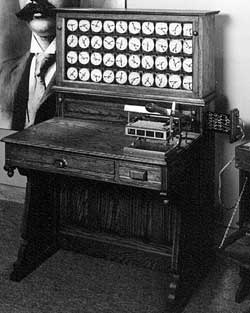
Having completed
the 1880 census with only months to spare, the U.S. Bureau of the Census
established a competition for a technological solution for the 1890 tally.
A young engineer, named Herman Hollerith, won the competition by proposing
a manual cardpunch with mechanical counting (tabulating) dials.
Each machine used
pin presses and individual cups of mercury to form an electrical circuit,
the tabulating dials incrementing one position for each such contact closure.
For the 1890 census, 62M cards were punched (700/clerk/day) and counted
by 100 of Hollerith's census machines (1000 cards/hour/machine). In spite
of this success, Hollerith had only one customer who bought equipment
once a decade, making it a struggle to form a viable company. He incorporated
TMC (Tabulating Machine Co.) in 1896 to sell business-oriented machines,
but had to gear up again for the 1900 census.
By 1911 he had
100 customers and was no longer dependent exclusively on census contracts.
Hollerith's firm merged with Computing Scale Company and International
Time Recording Company to form C-T-R (Computing-Tabulating-Recording)
Company. In 1911 Thomas J. Watson joined to take over the firm and Hollerith
retired as a wealthy entrepreneur. In 1924, the company name was changed
to IBM.
|








